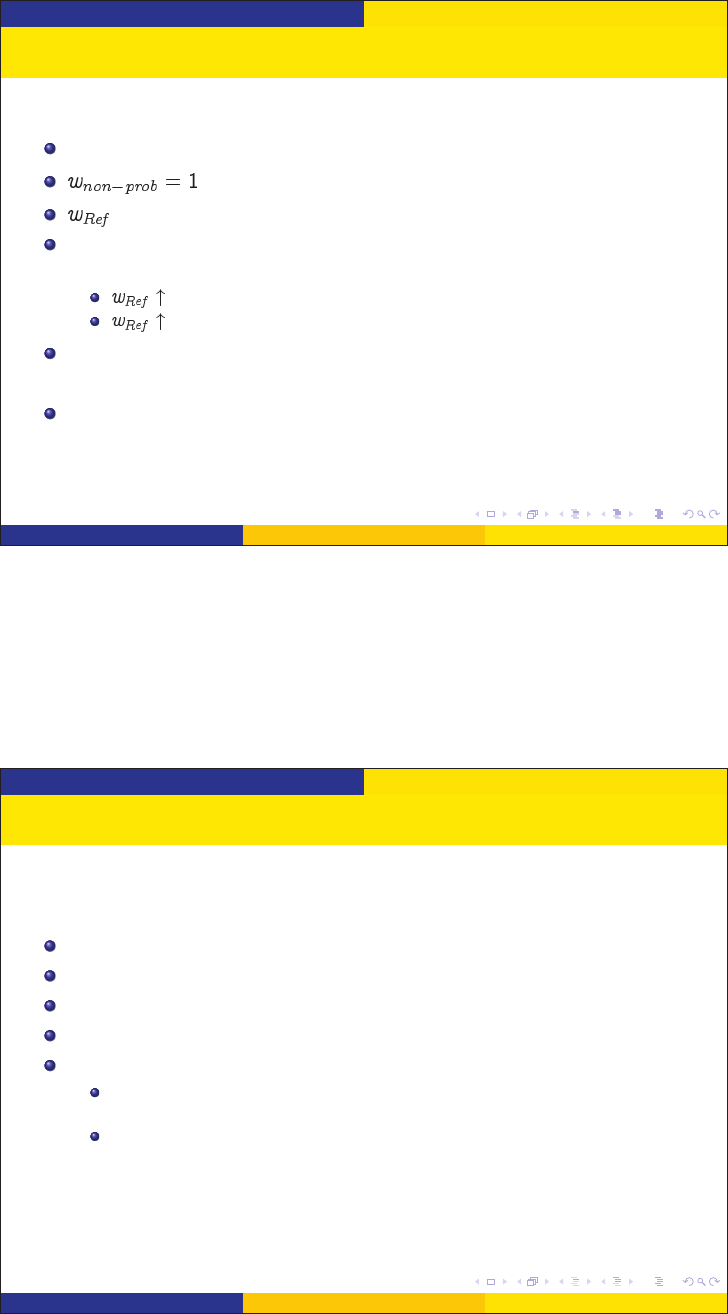
Non-probability Sampling for Finite Population
Inference
Jill A Dever & Richard Valliant
RTI International & Universities of Michigan and Maryland
AAPOR Webinar (October 18, 2016)
1 / 43
New Sources, New Problems
Webinar Goals
Understand the different types of non-probability samples
currently in use
Understand how non-probability samples can be affected by
errors such as coverage and nonresponse
Understand what methods of estimation can be used for
non-probability samples and the arguments used to justify them
2 / 43

New Sources, New Problems
Motivation for Non-probability Sampling
Low response rates for many probability samples (Kohut et al.
2012)
Ever increasing costs with ever decreasing funds
Nonsampling errors
The need for speed
Data are everywhere just waiting to be analyzed!!!
3 / 43
New Sources, New Problems
Examples of “New-ish” Sources of Data
Twitter
Facebook
Snapchat
Mechanical Turk
SurveyMonkey
Web-scraping
Pop-up Surveys
Data warehouses
Probabilistic matching of multiple sources
4 / 43

New Sources, New Problems
New Sources of Data: Example Studies
Analysis of medical records including text to predict heart disease (Giles &
Wilcox 2011)
Correlates of local climate & temperature with spread of infectious disease
(Global Pandemic Initiative)
MIT’s Billion Prices Project–Price indexes for 22 countries from web-scraped
data
Marketing of e-cigarettes (Kim et al. 2015)
Political polls and political issues (e.g., Clement 2016; Conway et al. 2015;
Dropp & Nyhan 2016)
Prediction of social stability (e.g., Kleinman 2014)
Public health events, outbreaks (Harris et al. 2014; Kim et al. 2012)
Research on subscribers to PatientsLikeMe.com
Ad-hoc surveys via Amazon’s Mechanical Turk
Google flu and dengue fever trends (defunct)
5 / 43
New Sources, New Problems
Probability vs. Non-probability Samples
Probability sampling:
Presence of a sampling frame linked to population
Every unit has a known probability of being selected
Design-based theory focuses on random selection mechanism
Probability samples became touchstone in surveys after Neyman
(JRSS 1934) article
Non-probability sampling:
Investigator does not randomly pick units with KNOWN
probabilities
No population sampling frame available/desired
Underlying population model is important
Differing opinions on reporting estimates of error
6 / 43

New Sources, New Problems
Probability vs. Non-probability Samples
We focus on surveys with the goal to use sample to make
estimates for
entire finite population—external validity
Many applications of big data analysis use non-probability
samples. Population may not be well defined.
Many probability surveys have such low RRs they basically are
non-probability samples
Pew Research response rates in typical telephone surveys dropped from 36%
in 1997 to 9% in 2012 (Kohut et al. 2012)
Recommendations for using non-probability samples:
AAPOR task force reports on non-probability samples (2013) & online
samples (2010)
Perils and potentials of self-selected entry (Keiding & Louis 2016)
7 / 43
New Sources, New Problems
Three Categories of Non-probability Samples
Convenience—units at hand selected; notion overlaps with
accidental, availability, opportunity, haphazard or unrestricted
sampling
Matched—units are drawn into study (panel) based on
characteristics, i.e., controlled selection
Network—a set of units form starting seeds, which sequentially
lead to additional units selected (aka snowball, respondent driven
sampling)
(Note: Sirken network sampling is an exception)
8 / 43

New Sources, New Problems
Types of Convenience Samples
Volunteer sampling—recruitment at events (e.g. sports, music, etc.)
and other locations (e.g. mall intercept, street recruitment), limited (if
any) refusal conversion
River sampling—general or study-specific invitation through
banner/pop-up web ads, etc.
Mail-in surveys—type of volunteer sampling with paper-and-pencil
questionnaires, distributed as leaflets at public locations (e.g. hotels,
restaurants) or enclosed in magazines, journals, newspapers, etc.)
Tele-voting (text message)—type of volunteer sampling where people
are invited to express their vote by calling-in or by sending a text (TV
shows, contests)
Observational—“you get what you see”
9 / 43
New Sources, New Problems
Types of Matched Samples
Purposive sampling—selection follows some judgment or
arbitrary ideas of looking for a “representative” sample
Expert selection—subject experts pick the units, e.g., two most
typical settlements selected from a region
Quota sampling—sample “improved” by obtaining targeted
socio-demographic quotas (e.g. region, gender, age) to reflect
population distribution
Balanced sampling
10 / 43

New Sources, New Problems
Comments on Balanced Sampling
Samples selected until means or other quantities match the
population (Särndal et al. 2003)
Estimates are either unweighted (e.g., average) or via a model
Quota sampling is a subset and focuses only on observable
characteristics
Shown to protect against misspecified inferential models
(Royall & Herson 1973; Valliant et al. 2000)
For probability-based balanced sampling
Survey weights are required (e.g., Horvitz-Thompson estimation)
Cube method randomly chooses from a set of balanced samples
(Deville & Tillé 2004)
11 / 43
New Sources, New Problems
Survey Errors
Coverage
Selection bias
I Coverage and/or selection bias is a problem if the seen (sample) part of the
population differs from the unseen (nonsample) in such a way that the sample
cannot be projected to the full population
Nonresponse
I (some unknown nonresponse for non-probability surveys)
Attrition
Measurement error (e.g., satisficing—provide an acceptable
answer instead of the correct one)
12 / 43

New Sources, New Problems
Non-probability Electoral Polls: Many Failures
Early failure of a non-probability sample
1936 Literary Digest mail survey
2.3 million subscribers plus automobile and telephone owners
Predicted landslide win by Alf Landon over FDR
Excluded core lower-income supporters of FDR
More recent failures
British parliamentary election May 2015
Sturgis et al. (2016) is a post mortem
Israeli Knesset election March 2015
Scottish independence referendum, Sep 2014
US state of Michigan democratic primary, 2016
13 / 43
New Sources, New Problems
Non-probability Electoral Polls: One that Worked
Xbox gamers: 345,000 people surveyed in opt-in poll for 45 days
continuously before 2012 US presidential election
Xboxers much different from overall electorate:
18- to 29-year olds were 65% of dataset, compared to 19% in
national exit poll
93% male vs. 47% in electorate
Unadjusted data suggested landslide for Romney
Wang et al. (2015) used multilevel regression and
poststratification to get good estimates with covariates
sex, race, age, education, state, party ID, political ideology, and
who they voted for in the 2008 presidential election
14 / 43

New Sources, New Problems
Comparing Probability and Non-probability Samples
Mixed results
Kennedy et al. (2016)—compared 9 non-probability and 1
probability sample
Dutwin & Buskirk (2016)—some techniques show benefits (e.g.,
sample matching) but ....
Tourangeau et al. (2013)—examined wt adjustments for 8 opt-in
web panels using weight with mixed results
Yeager et al. (2011)—compared RDD and non-probability internet
survey with results varying by type of variable
Valliant & Dever (2011)—effective propensity scores are possible
with weighted reference survey cases
15 / 43
Inference Problem
Universe & Sample
EŽƚ
ĐŽǀĞƌĞĚ
ŽǀĞƌĞĚ
For example ...
= adult population
= adults without internet access
= adults with internet access
= adults with internet access who visit some webpage(s)
= adults who volunteer for a panel
16 / 43

Inference Problem
Illustration of a Coverage Problem
Volunteer web panel surveyed about voting intentions
Support for 2 candidates differs by age group
Suppose the panel has no one in older groups
17 / 43
Inference Problem
Correcting for Sample Imbalance
Quota sampling or other type of controlled recruiting
(YouGov/Polymetrix); no weights needed
Weights to correct imbalance of sample compared to pop
Two approaches to weighting
1
Quasi-randomization weighting
2
Superpopulation modeling of ’s
Both involve modeling
18 / 43

Inference Problem
Flavors of Missing Data
MCAR (Missing completely at random)
—Every unit has same probability of appearing in sample
MAR (Missing at random)
—Probability of appearing depends on covariates known for
sample and nonsample cases
NMAR (Not missing at random)
—Probability of appearing depends on covariates and ’s
19 / 43
Inference Problem
Population Inference: Estimating a Total
Pop total
To estimate , predict 2nd, 3rd, and 4th sums
EŽƚ
ĐŽǀĞƌĞĚ
ŽǀĞƌĞĚ
What if non-covered units are much different from covered?
Difference from a bad probability sample with a good frame but
low RR:
I No unit in or had any chance of appearing in the
sample
20 / 43

Methods of Inference Quasi-randomization
Population Inference: Quasi-randomization Approach
Model probability of appearing in sample
Probabilities are sometimes estimated with special Reference
(probability) sample or an existing sample (ACS, NHIS, etc.)
21 / 43
Methods of Inference Quasi-randomization
Population Inference: Quasi-randomization Approach
Propensity score method:
Put and reference sample together
Estimate pseudo-inclusion probability via binary
regression
Use as a weight
Model covariates:
demographic items
webographic (attitudinal) items
–mixed results (Schonlau et al. 2007; Lee et al. 2009))
covariates highly correlated with ’s (Lee 2006; Dever et al. 2015)
22 / 43

Methods of Inference Quasi-randomization
Population Inference: Quasi-randomization Approach
Binary regression to estimate propensity scores:
Code non-probability cases = 1; reference cases = 0
for non-probability sample cases
= survey weight for reference survey cases
Propensities estimate probability of being in non-prob sample
within whatever pop the reference weights to. Cases:
adult pop with internet access
adult pop regardless of internet access
Caveats—reference survey weighting must correct for any
coverage and nonresponse error
Poststratification, raking, or other calibration often applied after
getting pseudo-inclusion probabilities
23 / 43
Methods of Inference Quasi-randomization
Population Inference: Quasi-randomization Approach
Assumptions important for propensity score methods (Valliant & Dever
2011):
Surveys are disjoint (no respondent overlap)
Nonparticipants in non-probability survey are MAR
Large reference survey from target population
Identical key items on covariates in both questionnaires
Propensity scores:
have common support in reference and non-probability (distributions
overlap)
estimated with reference survey weights
24 / 43

Methods of Inference Model for
Population Inference: Superpopulation “Prediction”
Approach
Use a model to predict the value for each nonsample unit (Valliant
et al. 2000)
Linear model:
If this model holds, then
Note: Nonlinear models require individual ’s for nonsample units
25 / 43
Methods of Inference Model for
Population Inference: Superpopulation (Prediction)
Approach
, where
is matrix of covariates for the sample units
is the -vector of sample ’s
Resulting weight:
where = vector of totals for nonsample units
Note: With this , weights do not depend on ’s
Similar structure to generalized regression estimation (GREG)
26 / 43

Methods of Inference Model for
’s & Covariates
If is binary, a linear model is being used to predict a 0-1 variable
I Done routinely in surveys without thinking explicitly about a
model
Every may have a different model pick a set of ’s good for
many ’s
I Same thinking as done for GREG and other calibration
estimators
Undercoverage: use ’s associated with coverage
I Also done routinely in surveys
27 / 43
Methods of Inference Model for
Modeling Considerations
Good modeling should consider how to predict ’s and how to
correct for coverage errors
Covariate selection: LASSO, CART, random forest, boosting,
other machine learning methods
Covariates: an extensive set of covariates needed
(Dever, Rafferty & Valliant 2008; Valliant & Dever 2011; Wang et al. 2015)
Model fit with sample needs to hold for nonsample (difficult
[impossible?] to prove)
28 / 43

Methods of Inference
Pros and Cons with Quasi-Randomization and
Superpopulation
Quasi-randomization
Pro = general weights for estimating any
Con = possible bias with respect to the superpopulation model for
Superpopulation
Pro = model-specific estimators with lower variance than quasi-randomization
Con = possible bias with respect to the superpopulation model for
Notes: Model misspecification a worry for both
Bayesian variations available for each
See review paper by Elliott & Valliant (forthcoming)
29 / 43
Methods of Inference
Software
Quasi-randomization
Propensity classes: pclass function in R PracTools package (Valliant et al.
2015)
WTADJUST and WTADJX in SUDAAN 11 (Kott 2016; RTI 2012)
Custom-written software in SAS, Stata, R, etc.
Superpopulation modeling
calibrate function in R survey package (Lumley 2014)
ReGenesees in R (Zardetto 2015)
WTADJUST and WTADJX in SUDAAN 11 (Kott 2016; RTI 2012)
ipfraking in Stata (Kolenikov 2014)
sreweight in Stata (Pacifico 2014)
svycal in future version of Stata
Set weights to 1 in design-based calibration routines
30 / 43

Simulation Comparisons
Simulation Study: Set-up (Valliant & Dever 2011)
Data: 2003 Michigan Behavioral Risk Factor Surveillance Survey
(MI BRFSS)
2,845 sample persons bootstrapped to study
population
simulation runs with two samples:
1
Volunteer sample
Volunteers selected by Poisson sampling; (expected)
Logistic regression for volunteering; probabilities based on having
internet access
Volunteering probabilities generated with logistic regression with
covariates: age, race, gender, wireless phone, education, income
2
Reference sample—srswor of from non-volunteers
31 / 43
Simulation Comparisons
Simulation Study: 4 Estimators Evaluated
1
individual propensity weights (1: propensity wts)
2
average propensity weights in each of five subclasses (2: avg
propensity wts)
3
propensity-poststratified estimator (3: propensity PS)
4
calibration to population totals of covariates (no propensity
adjustment) using a regression estimator (4: calibration to X);
example of a prediction estimator
10,000 simulations with 500 in each volunteer & reference samples
32 / 43

Simulation Comparisons
Simulation Study: Statistical Results
33 / 43
Simulation Comparisons
Simulation Study: Key Findings
Reference survey weights need to be used to estimate
propensities of volunteering
Estimates with individual propensities or average propensity
weights within classes are biased with unweighted propensity
estimates, but less so with weighted
Propensity-poststratification poor with unweighted or weighted
propensity estimates
GREG and estimate with individual propensity weights generally
have smallest biases
If probability of volunteering depends on analysis variables, all
estimators are biased
34 / 43

Simulation Comparisons
Other Research
Desire to compare estimates from non-probability against “the
truth” leads researchers to contrast probability and non-probability
surveys
Quasi-randomization techniques do not always work
(e.g., Dever & Brown 2016; Willis et al. 2015; Rothschild & Goel 2014; Valliant &
Dever 2011; Yeager et al. 2011; Lee & Valliant 2009; Schonlau et al. 2009;
Rivers 2007; Duffy et al. 2005)
Limited comparisons with model-based estimation
Lingering concerns
Were right covariates available?
Were they used correctly—multiway interactions?
Poor modeling leads to biased estimators
35 / 43
Simulation Comparisons
Variance estimation
Quasi-randomization
Treat pseudo-inclusion probabilities in same way as designed-based selection
probabilities
Design-based variance estimators apply. Justification is consistency under
quasi-randomization distribution
Linearization or replication can be used
Replication shows most promise (Lee & Valliant 2009)
Need to decide whether strata and clusters are appropriate
Superpopulation modeling
Compute variance under model used for point estimates with variance based on
squared residuals
Replication estimators also justified (Valliant et al. 2000)
Bayesian models, e.g., credibility interval (Santos, Buskirk & Gelman 2012)
with(out) applying survey design effects
Justification is consistency under superpopulation model
36 / 43

The Future
Takeaway
Non-probability samples do not have the (false?) assurance of
complete population coverage that probability samples do
Inference to finite populations is possible but only with either
correct modeling of
Chance of being in sample, or
Dependence of analysis variables on covariates
Convincing users that a non-probability sample represents
nonsample part of population will always be an issue
(true for low RR probability samples, too)
37 / 43
The Future
Diagnostics
Work needed on diagnostics for "representativity"
Are non-probability estimates aiming at desired target population?
Distance measure
= set of estimates from non-probability sample
= values from some reliable data source (ACS, NHIS, CPS,
census, etc.)
Compare to a chi-square distribution or
Validation items in are not used in non-probability weight
calculation; may not be of direct interest in the survey
38 / 43

The Future
The Future .....
Quasi-randomization—model pseudo-inclusion probabilities
Superpopulation models—model the ’s
Combination
Which is better???
39 / 43
The Future
The Future .....
Quasi-randomization—model pseudo-inclusion probabilities
Superpopulation models—model the ’s
Combination
Which is better???
39 / 43

References
Baker R, Brick JM, Bates N, Couper M, Courtright M, Dennis J, et al (2010). AAPOR report on online panels. Public
Opinion Quarterly, 74:711–781.
Baker R, Brick JM, Bates NA, Battaglia M, Couper MP, Dever JA, Gile K, & Tourangeau R (2013). Summary report of the
AAPOR task force on non-probability sampling. Journal of Survey Statistics and Methodology, 1:90–143.
Clement S (2016). How The Washington Post-SurveyMonkey 50-state poll was conducted. The Washington Post, 6 Sep
2016. Accessed 25 Sep 2016.
Conway BA, Kenski K & Wang D (2015). The Rise of Twitter in the Political Campaign: Searching for Intermedia
Agenda-Setting Effects in the Presidential Primary. Journal of Computer-Mediated Communication, 20(4):363–380.
Deville J-C & Yves Tillé Y (2004). Efficient balanced sampling: the cube method. Biometrika, 91(4):893–912.
Dever JA & Brown D (2016, May). Estimated-Control calibration for non-probability surveys. Presented at AAPOR 71st
annual conference, Austin, TX.
Dever JA, Rafferty A & Valliant R (2008). Internet Surveys: Can Statistical Adjustments Eliminate Coverage Bias? Survey
Research Methods 2:47–62.
Dever JA, Shook-Sa BE & Valliant R. (2015, Sep). Can estimated-control calibration reduce bias in estimates from
nonprobability samples? Presented at WSS Mini-Conference on Non-probability Samples, Washington, DC.
Dropp K & Nyhan B (2016). The 2016 Race: It Lives. Birtherism Is Diminished but Far From Dead. The New York Times,
23 Sep 2016. Accessed 25 Sep 2016.
Duffy B, Smith K, Terhanian G & Bremer J (2005). Comparing data from online and face-to-face surveys. International
Journal of Market Research, 47(6):615–639.
Dutwin D & Buskirk TD (2016). Apples to Oranges or Gala vs. Golden Delicious: Comparing Data Quality of
Nonprobability Internet Samples to Low Response Rate Probability Samples. Presentation at the AAPOR 71st annual
conference, Austin, TX.
Elliott MR & Valliant R (2017). Inference for non-probability samples. Statistical Science, 31(1):forthcoming.
Giles T & Wilcox R (2011). IBM Watson and Medical Records Text Analytics. Presentation at the Healthcare Information
and Management Systems Society meeting.
https://www-01.ibm.com/software/ebusiness/jstart/downloads/MRTAWatsonHIMSS.pdf. Accessed 25
Sep 2016.
40 / 43
References
Harris JK, Mansour R, Choucair B, Olson J, Nissen C, & Bhatt J (2014). Health Department Use of Social Media to
Identify Foodborne Illness—Chicago, Illinois, 2013–2014. Morbidity and Mortality Weekly Report, 63(32):681–685.
Keiding N & Louis TA (2016). Perils and potentials of self-selected entry to epidemiological studies and surveys. Journal
of the Royal Statistical Society, Series A, 179(2):319–376.
Kennedy C, Mercer A, Keeter S, Hatley N, McGeeney K & Gimenez A (2016). Evaluating Online Nonprobability Surveys.
Pew Research Center report, 2 May 2016. Accessed 1 Oct 2016.
http://www.pewresearch.org/2016/05/02/evaluating-online- nonprobability-surveys/
Kim AE, Hansen HM, Murphy J, Richards AK, Duke J & Allen JA (2013). Methodological Considerations in Analyzing
Twitter Data. Journal of the National Cancer Institute Monographs, 47:140–146.
Kim AE, Hopper T, Simpson S, Nonnemaker J, Lieberman AJ, Hansen H, Guillory J, & Porter L (2015). Using Twitter
Data to Gain Insights into E-cigarette Marketing and Locations of Use: An Infoveillance Study. J Med Internet Res,
17(11):e251.
Kim A, Richards AK, Murphy JJ, et al. (2012). Can automated sentiment analysis of Twitter data replace human coding?
Paper presented at American Association for Public Opinion Research Annual Conference; May 18, 2012; Orlando, FL.
Kleinman A (2014). Facebook Can Predict With Scary Accuracy If Your Relationship Will Last. The Huffington Post, 14
Feb 2014. Accessed 25 Sep 2016.
Kohut A, Keeter S, Doherty C, Dimock M, & Christian L (2012). Assessing the representativeness of public opinion
surveys. http://www.people- press.org/2012/05/15/
assessing-the- representativeness-of- public-opinion- surveys, 15 May 2012. Accessed 9 Sep 2016.
Kolenikov, S (2014) Calibrating survey data using iterative proportional fitting (raking). Stata Journal 14(1): 22–59.
Kott PS (2016). Calibration weighting in survey sampling. WIREs Computational Statistics, 8:39–53.
Lee S (2006). Propensity score adjustment as a weighting scheme for volunteer panel web surveys. Journal of Official
Statistics, 22(2):329–349.
Lee S & Valliant R (2009). Estimation for volunteer panel web surveys using propensity score adjustment and calibration
adjustment. Sociological Methods & Research, 37:319–343.
41 / 43

References
Lumley, T (2014). survey: analysis of complex survey samples. R package version 3.30.
http://CRAN.R-project.org/package=survey.
Neyman J (1934). On the two different aspects of the representative method: the method of stratified sampling and the
method of purposive selection. Journal of the Royal Statistical Society, 97:558–625.
Research Triangle Institute (2012). SUDAAN Language Manual, Volumes 1 and 2, Release 11. Research Triangle Park,
NC: Research Triangle Institute. www.rti.org/sudaan
Rivers D (2007). Sampling for web surveys. Proceedings of the American Statistical Association, Section on Survey
Research Methods. Paper presented at the Joint Statistical Meetings, Salt Lake City, UT.
http://s3.amazonaws.com/static.texastribune.org/media/documents/Rivers_matching4.pdf
Rothschild D & Goel S (2014). Non-Representative Surveys: Fast, Cheap and Mostly Accurate. Presentation given at the
AAPOR 70st annual conference, Hollywood, FL.
Royall R & Herson J (1973). Robust estimation in finite populations I. Journal of the American Statistical Association,
69:880-889.
Santos R, Buskirk T, & Gelman A (2012). Understanding a “credibility interval” and how it differs from the “margin of
sampling error” in a public opinion poll. Statement from AAPOR Ad Hoc Committee on Credibility Interval, 7 Oct 2012.
Accessed 10 Oct 2016. https://www.aapor.org/AAPOR_Main/media/MainSiteFiles/
DetailedAAPORstatementoncredibilityintervals.pdf
Särndal CE, Swensson B, & Wretman J (2003). Model Assisted Survey Sampling, Section 14.4. New York, NY:
Springer-Verlag, Inc.
Schonlau M, Van Soest A, & Kapteyn A (2007). Are ‘Webographic’ or attitudinal questions useful for adjusting estimates
from Web surveys using propensity scoring? Survey Research Methods, 1(3):155-163.
Schonlau M, van Soest A, Kapteyn A, & Couper M (2009). Selection Bias in Web Surveys and the Use of Propensity
Scores. Sociological Methods Research, 37(3):291–318.
Sirken M (1970). Household surveys with multiplicity. Journal of the American Statistical Association, 65:257–266.
Sturgis, P, Baker, N, Callegaro, M, Fisher, S, Green, J, Jennings, W, Kuha, J, Lauderdale, B, and Smith, P (2016). Report
of the Inquiry into the 2015 British general election opinion polls.
http://eprints.ncrm.ac.uk/3789/1/Report_final_revised.pdf.
42 / 43
References
Tourangeau R., Conrad FG, & Couper MP (2013). The Science of Web Surveys. New York:Oxford University Press.
Valliant R & Dever JA (2011). Estimating propensity adjustments for volunteer web surveys. Sociological Methods and
Research, 40: 105–137.
Valliant R, Dever JA, & Kreuter F (2015). PracTools: Tools for Designing and Weighting Survey Samples. R package
version 0.3. http://CRAN.R-project.org/package=PracTools.
Valliant R, Dorfman A & Royall R (2000). Finite population sampling and inference: a prediction approach. New York:
Wiley.
Vehovar V, Toepoel V, & Steinmetz S (2016). Non-probability sampling. The SAGE Handbook of Survey Methodology,
chap. 22. London: Sage.
Yeager DS, Krosnick JA, Chang L, Javitz HS, Levendusky MS, Simpser A, & Wang R (2011). Comparing the accuracy of
RDD telephone surveys and internet surveys conducted with probability and non-probability samples. Public Opinion
Quarterly, 75:709–747.
Wang W, Rothschild D, Goel S, & Gelman A (2015). Forecasting elections with nonrepresentative polls. International
Journal of Forecasting, 31:980–991. http://www.stat.columbia.edu/~gelman/research/published/
forecasting-with- nonrepresentative-polls.pdf
Willis GB, Chowdhury SR, de Moor JS, Ekwueme D, Kent E, Liu B, et al. (2015). A Comparison of Surveys Based on
Probability Versus Non-Probability Sampling Approaches. Presentation given at the AAPOR 70st annual conference,
Hollywood, FL.
Zardetto, D (2015). ReGenesees: an Advanced R System for Calibration, Estimation and Sampling Error Assessment in
Complex Sample Surveys. Journal of Official Statistics, 31(2): 177–203.
43 / 43
